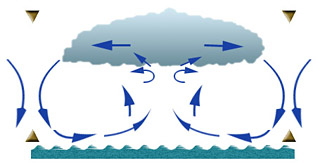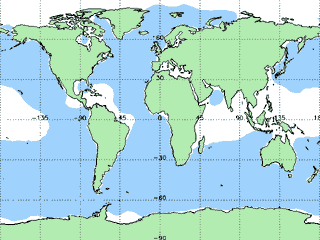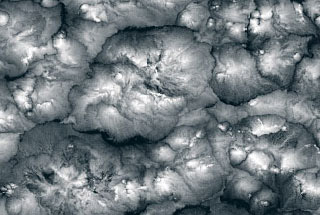
"Convective Cells"
"Close Cell" Structure(CCS)
Some of the CCS are polygonal, round or oval, the others are often stay
close to each other and form large fields up to more than a million square
kilometers in size. Occasionally single cells may be discovered. The larger
the cell is, the clearer its borders are (seen as thin lines). Through
these lines the sea surface can be watched.
The area extent of an individual cell unit is from several kilometers
to one hundred or even more kilometers.
The Cloud top heigh is normally from several hundred meters up to 2÷2.5
km., sometimes 1÷2 km., rarely up to 3÷3.5 km.
Albedo is 0.7÷0.8 (up to 0.9).
The 'Close Cell' Cloud Structure may shape:
- above areas situated in middle latitudes where the temperature difference
between the sea surface and the troposphere is little,
- at the edge of cyclones vortices in middle latitudes,
- above polar seas
The 'Close Cell' Cloud Structures are usually found (depending on
the season) in the latitude of > 30° and <-20°.
It also occurs in the
Northern Hemisphere above the Eastern part of the Atlantic and Pacific
oceans, as well as above the Arabian Sea in the Indian Ocean, above the
equator on the western coast of Africa and above South Americas Waters.
In the Southern Hemisphere it extends up to the equator. Above Australian
waters it stretches up to the latitude of 15°. Above the polar seas the
clouds are semitransparent and consist of a quantity of small deep flowing
cells.
This type of CS can be also found above the land, mostly the plains.
Various physical phenomena can emerge and be seen on the cloudiness of
this structure type, besides other types of structures may use the said
structure as the foundation for their evolution.
 The Closed cells consist of convective clouds and their circulation is
vertical. These cells appear frequently in the atmospheric layer in rough
hexagonal rows, and consist of Stratocumulus and Stratus clouds. The sides
of the cloud tops are kept down by the inversion layer. Closed cells appear
when the temperature difference between the sea surface and the troposphere
is minor. They may shape when the inflow of cool air is weak. Besides,
they can convert from Opened cells in the event that the flowing cool
air subsides. In this case the future form of cells (opened or closed)
depends on the intensity of the inflow of the cool air. However this process
is very chaotic and it is very difficult to predict the result of convention.
Sometimes the conditions of the atmosphere change, which gives rise to
curious forms of clouds.
The Closed cells consist of convective clouds and their circulation is
vertical. These cells appear frequently in the atmospheric layer in rough
hexagonal rows, and consist of Stratocumulus and Stratus clouds. The sides
of the cloud tops are kept down by the inversion layer. Closed cells appear
when the temperature difference between the sea surface and the troposphere
is minor. They may shape when the inflow of cool air is weak. Besides,
they can convert from Opened cells in the event that the flowing cool
air subsides. In this case the future form of cells (opened or closed)
depends on the intensity of the inflow of the cool air. However this process
is very chaotic and it is very difficult to predict the result of convention.
Sometimes the conditions of the atmosphere change, which gives rise to
curious forms of clouds.
|

